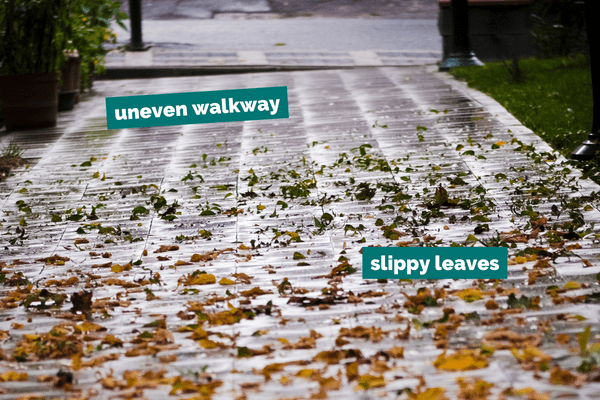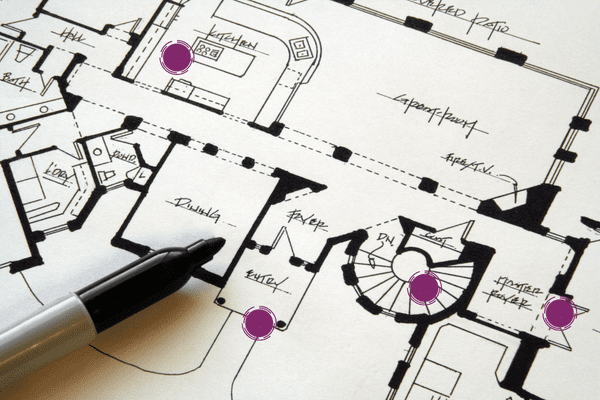Carpets or vinyl, desks or kitchen worktops – your businesses’ slips, trips, and falls opportunities are not necessarily going to be the same as the next, even if you do work in the same sector.
Either way, the stats are clear: slips trips and falls account for the most serious injuries in the workplace. The risk is indiscriminate, as it can happen to anyone, anytime and anywhere.
Here is just a snapshot of the kind of accidents waiting to happen, and ways to prevent them:
Outside
The hazards: With slippery leaves, mud, and moss in the autumn, icy walkways in the winter, and rain all year round, it’s safe to say we live in a country that’s primed to cause slip hazards outside.
Remedies: Cutting back overhanging plants means less foliage to shed, while an alternative route or gritting might be necessary for icy weather. Encourage delivery workers to leave feedback on any uneven slabs or cracks they notice, by leaving a form and a pen at the entrance to the building.

Inside
The hazards: Rainwater on vinyl flooring, personal possessions left on the floor by desks, bad seals on equipment or machinery; there can be risks at every turn indoors. And just like outside, you could do with some help identifying them.
Remedies: Remind colleagues to keep their immediate workspace tidy. If bags or other items are often left on the floor, perhaps more storage is needed. An entrance mat is the easiest way to absorb rainwater, but if that doesn’t work, a fully carpeted floor might be the way forward. Frequent engagement with your colleagues will encourage feedback on something you might have missed.
These examples should hopefully get you thinking about what could be around the corner at your workplace, but you might need to dig deeper to reveal further issues. Here are four ways to do just that:
1. Create a hazard map
A mapping tool is an effective way to visualise the risks that are unique to your company. By plotting out an aerial view and gathering feedback, you can pick up on the less obvious obstacles and address them before they become an accident waiting to happen. Maybe the light is a little too slow switching on in the toilets, or there’s no obvious place for packages to be left when delivering. If it’s a potential hazard, it needs your attention.

2. Review frequently
Rearranging the workspace can make way for new recruits or a slicker process, but can also throw up some risks that weren’t there before. That’s why it’s important to revisit (and potentially redraw) your risk assessment and hazard map after moving things around.
3. Look beyond the environment
Are there any medical conditions that make a team member more at risk of a fall? Heart disease and low blood pressure can both cause dizzy spells, while osteoporosis in older workers can result in a worse injury, such as broken bones, should they fall.
Consider whether your employee wellbeing programme caters to these conditions.
Eyecare subsidiaries can encourage employees to visit the opticians to identify blurred vision and gentle physical activity can improve balance and strengthen muscles.
You can bring this to your workplace by trialling walking meetings – which bring the added benefit of a boost in creative thinking – or offering to pay for or hold exercise classes. Thanks to its zero contact and focus on movement, balance, and coordination, Tai Chi has been known to reduce the risk of falls in someone who practices regularly.
4. Consider those working alone
Are there times when you have someone locking up on their own, coming in early, or leaving late? Even if there are measures to protect these workers against preventable slips trips and falls, you can’t always stop them from happening.
But you can make sure that those who are in the workplace on their own have someone looking out for them. Our PG Smart App has a fall detection feature that sends an SOS when it senses that the person carrying it has had a fall.
Here’s how it works:
This SOS can be turned off before it sounds (after 20 seconds) to prevent a false alarm. If not, this will alert an Alarm Receiving Centre, either ours at Pick Protection or your own. You can even have the SOS sent to named emergency contacts.
Visit the HSE website to view their Slips, Trips and Mapping tool so you can start planning.
Get in touch
To find out more about our PG Smart and other lone-worker solutions, get in touch with the team, and we’d be happy to answer any questions you may have.
